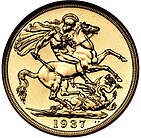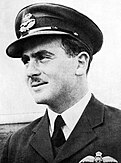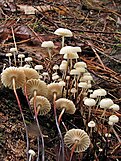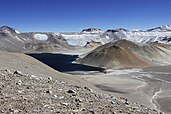User:Tkgd2007/Portal
Featured articles
The double sovereign is a gold coin of the United Kingdom with a nominal value of two pounds sterling (£2). It features the reigning monarch on its obverse and, most often, Benedetto Pistrucci's depiction of Saint George and the Dragon on the reverse (pictured). It was rarely issued in the first century and a half after its debut in 1820, usually in a new monarch's coronation year or to mark the institution of a new coinage portrait of the monarch. In addition to the usual coinage in Britain, specimens were struck at Australia's Sydney Mint in 1887 and 1902. Most often struck as a proof coin, the double sovereign has been issued for circulation in only four years, and few examples worn from commercial use are known. It is now a collector and bullion coin, and has been struck by the Royal Mint most years since 1980. In some years, it has not been issued and the Royal Mint instead placed gold versions of the commemorative £2 piece in the annual gold proof sets. (Full article...)

Saving Private Ryan is a 1998 American epic war film directed by Steven Spielberg and written by Robert Rodat. Set in 1944 in France during World War II, it follows a group of soldiers, led by Captain John Miller (Tom Hanks), on their mission to locate Private James Francis Ryan (Matt Damon), who is to be brought home after his three brothers are killed in action. Inspired by the books of Stephen E. Ambrose and accounts of the deaths of members of a single family such as the Niland brothers, Rodat drafted the script and Paramount Pictures hired him to finish the writing. Spielberg wanted to make Saving Private Ryan as authentic as possible, and hired Frank Darabont and Scott Frank to perform uncredited rewrites based on research and interviews with veterans. The cast went through a week-long boot camp to understand the soldier experience. Filming took place from June to September 1997 in England and Ireland. Saving Private Ryan earned critical acclaim for its graphic portrayal of combat. (Full article...)
Munsey's Magazine was an American magazine founded by Frank Munsey in 1889. Originally launched in 1889 as Munsey's Weekly, it became an illustrated monthly in 1891, printing both fiction and non-fiction. In 1893 the price was reduced from 25 to 10 cents and circulation rose to more than 250,000 issues. The same year Munsey became one of the first publishers to regularly feature a pretty girl on the cover. Circulation was also helped by the liberal use of illustrations, and reached a peak of about 700,000 in 1897, declining in the 1910s. Well-known writers appeared, including O. Henry, Arthur Conan Doyle, Edgar Rice Burroughs, P. G. Wodehouse, and Joseph Conrad. In 1929 it was merged with Argosy, another of Munsey's magazines. Magazine historians consider Munsey's to have started a revolution in magazine publishing by setting a low price to increase circulation, and attracting sufficient advertising revenue to make a substantial profit. Other magazines quickly followed the example of Munsey's. (Full article...)
Bill Newton (8 June 1919 – 29 March 1943) was an Australian recipient of the Victoria Cross, honoured for his actions as a bomber pilot in Papua New Guinea during March 1943. Raised in Melbourne, he joined the Citizen Military Forces in 1938 and enlisted in the Royal Australian Air Force (RAAF) in February 1940. He served as a flying instructor in Australia before being posted to No. 22 Squadron, which began operating Boston light bombers in New Guinea late in 1942. Having just taken part in the Battle of the Bismarck Sea, he was on his fifty-second mission when he was shot down. Newton was still posted as missing when given the Victoria Cross in October 1943. It later emerged that he was captured by the Japanese and beheaded. Newton was the only Australian airman to receive a Victoria Cross for action in the South West Pacific theatre of World War II, and the sole Australian to be so decorated while flying with an RAAF squadron. (Full article...)
Marasmius rotula, the pinwheel mushroom, is a fungus in the family Marasmiaceae. Widespread in the Northern Hemisphere, it was first described scientifically in 1772 by Giovanni Antonio Scopoli. The mushrooms are characterized by thin whitish caps up to 2.0 cm (0.8 in) wide that are sunken in the center and pleated with scalloped margins. The wiry black hollow stalks measure up to 8.0 cm (3.1 in) long by 1.5 mm (0.06 in) thick. On the underside of the caps are widely spaced white gills, attached to a collar encircling the stalk. The mushrooms grow in groups or clusters on decaying wood such as moss-covered logs and stumps. Spore release is dependent upon sufficient moisture. Dried mushrooms may revive after rehydrating and release spores for up to three weeks, much longer than most gilled mushrooms. Although the mushrooms are not generally considered edible, they produce a unique peroxidase enzyme that is attracting research interest for use in bioengineering applications. (Full article...)
Ronald Reagan (1911–2004) was an American politician and actor who served as the 40th president of the United States from 1981 to 1989. Reagan graduated from Eureka College in 1932 and began to work as a sports broadcaster in Iowa. In 1937, he moved to California, and became a well-known film actor there. From 1947 to 1952, and from 1959 to 1960, Reagan served as the president of the Screen Actors Guild. He was defeated in his run for the Republican presidential nomination in the 1968 election as well as the 1976 election, but won both the nomination and election in 1980 election. As president, Reagan implemented new political initiatives as well as economic policies, advocating a laissez-faire philosophy, but the extent to which these ideas were implemented is debatable. The policies, dubbed "Reaganomics", included substantial tax cuts implemented in 1981. (Full article...)
Incapillo is a Pleistocene-age caldera – a depression formed by the collapse of a volcano – in La Rioja Province, Argentina. It is part of the southernmost volcanic centre in the Andean Central Volcanic Zone (CVZ). Subduction of the Nazca Plate beneath the South American Plate is responsible for most of the volcanism in the CVZ. Volcanism commenced in the Incapillo region 6.5 million years ago, forming the high volcanic edifices of Monte Pissis, Cerro Bonete Chico and Sierra de Veladero. Incapillo is known to have erupted the Incapillo ignimbrite 0.52 ± 0.03 and 0.51 ± 0.04 million years ago; this has a total volume of about 20.4 cubic kilometres (4.9 cu mi). A caldera with dimensions of 5 by 6 kilometres (3.1 mi × 3.7 mi) formed during the eruptions. Later volcanism generated more lava domes within the caldera and a debris flow in the Sierra de Veladero. The lake within the caldera may overlie an area of ongoing hydrothermal activity. (Full article...)
The Battle of Villers-Bocage took place on 13 June 1944 during World War II. Following the D-Day landings on 6 June, the Germans established defences in front of Caen. The British attacked in an attempt to exploit a gap in the German defences west of the city. They reached Villers-Bocage without incident in the morning but were ambushed by Tiger I tanks as they left the town and numerous tanks, anti-tank guns and transport vehicles were destroyed. The Germans then attacked the town but were repulsed. The British withdrew west of Villers-Bocage that evening and repulsed another attack the next day. The British conduct in the battle was controversial because their withdrawal marked the end of the post–D-Day "scramble for ground" and the start of an attritional battle for Caen. Some historians wrote that the British attack was a failure caused by a lack of conviction among some senior commanders; others judged the British force to be insufficiently strong for the task. (Full article...)
The Spider was an American pulp magazine published by Popular Publications from 1933 to 1943. Every issue included a lead novel featuring The Spider, a heroic crime-fighter. The novels in the first two issues were written by R. T. M. Scott; thereafter every lead novel was credited to "Grant Stockbridge", a house name. Norvell Page, a prolific pulp author, wrote most of these. Unlike some contemporary pulp heroes, The Spider was willing to kill criminals, and when he did so he left a red spider inked on his victims. Page in particular wrote stories with violent storylines, often with science-fiction plot devices. Continuity from novel to novel was often disregarded, with characters killed in one issue appearing unscathed in later issues. Each magazine also featured short stories, occasionally including elements of horror fiction. Most of the cover art was painted by John Newton Howitt or Rafael de Soto. The magazine was cancelled in 1943 due to a paper shortage caused by World War II. (Full article...)









